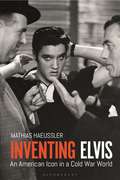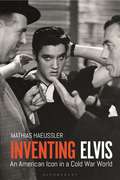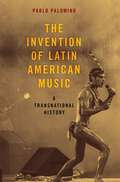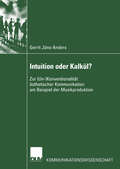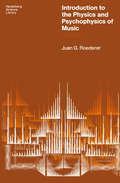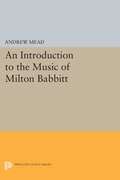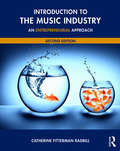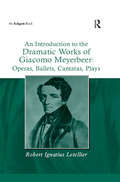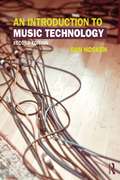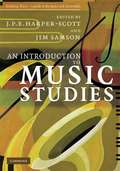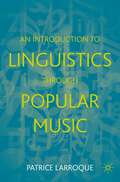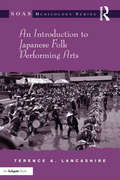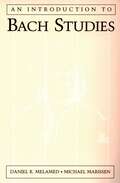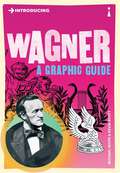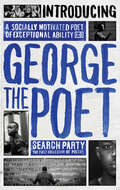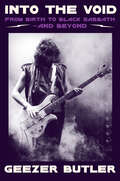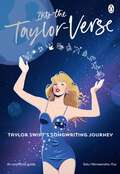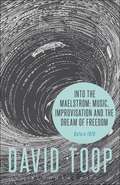- Table View
- List View
Inventing Elvis: An American Icon in a Cold War World
by Mathias HaeusslerElvis Presley stands tall as perhaps the supreme icon of 20th-century U.S. culture. But he was perceived to be deeply un-American in his early years as his controversial adaptation of rhythm and blues music and gyrating on-stage performances sent shockwaves through Eisenhower's conservative America and far beyond. This book explores Elvis Presley's global transformation from a teenage rebel figure into one of the U.S.'s major pop-cultural embodiments from a historical perspective. It shows how Elvis's rise was part of an emerging transnational youth culture whose political impact was heavily conditioned by the Cold War. As well as this, the book analyses Elvis's stint as G.I. soldier in West Germany, where he acted as an informal ambassador for the so-called American way of life and was turned into a deeply patriotic figure almost overnight. Yet, it also suggests that Elvis's increasingly synonymous identity with U.S. culture ultimately proved to be a double-edged sword, as the excesses of his superstardom and personal decline seemingly vindicated long-held stereotypes about the allegedly materialistic nature of U.S. society.Tracing Elvis's story from his unlikely rise in the 1950s right up to his tragic death in August 1977, this book offers a riveting account of changing U.S. identities during the Cold War, shedding fresh light on the powerful role of popular music and consumerism in shaping images of the United States during the cultural struggle between East and West.
Inventing Elvis: An American Icon in a Cold War World
by Mathias HaeusslerElvis Presley stands tall as perhaps the supreme icon of 20th-century U.S. culture. But he was perceived to be deeply un-American in his early years as his controversial adaptation of rhythm and blues music and gyrating on-stage performances sent shockwaves through Eisenhower's conservative America and far beyond. This book explores Elvis Presley's global transformation from a teenage rebel figure into one of the U.S.'s major pop-cultural embodiments from a historical perspective. It shows how Elvis's rise was part of an emerging transnational youth culture whose political impact was heavily conditioned by the Cold War. As well as this, the book analyses Elvis's stint as G.I. soldier in West Germany, where he acted as an informal ambassador for the so-called American way of life and was turned into a deeply patriotic figure almost overnight. Yet, it also suggests that Elvis's increasingly synonymous identity with U.S. culture ultimately proved to be a double-edged sword, as the excesses of his superstardom and personal decline seemingly vindicated long-held stereotypes about the allegedly materialistic nature of U.S. society.Tracing Elvis's story from his unlikely rise in the 1950s right up to his tragic death in August 1977, this book offers a riveting account of changing U.S. identities during the Cold War, shedding fresh light on the powerful role of popular music and consumerism in shaping images of the United States during the cultural struggle between East and West.
INVENT OF LATIN AMERICAN MUSIC CILAM C: A Transnational History (Currents in Latin American and Iberian Music)
by Pablo PalominoThe ethnically and geographically heterogeneous countries that comprise Latin America have each produced music in unique styles and genres - but how and why have these disparate musical streams come to fall under the single category of "Latin American music"? Reconstructing how this category came to be, author Pablo Palomino tells the dynamic history of the modernization of musical practices in Latin America. He focuses on the intellectual, commercial, musicological, and diplomatic actors that spurred these changes in the region between the 1920s and the 1960s, offering a transnational story based on primary sources from countries in and outside of Latin America. The Invention of Latin American Music portrays music as the field where, for the first time, the cultural idea of Latin America disseminated through and beyond the region, connecting the culture and music of the region to the wider, global culture, promoting the now-established notion of Latin America as a single musical market. Palomino explores multiple interconnected narratives throughout, pairing popular and specialist traveling musicians, commercial investments and repertoires, unionization and musicology, and music pedagogy and Pan American diplomacy. Uncovering remarkable transnational networks far from a Western cultural center, The Invention of Latin American Music firmly asserts that the democratic legitimacy and massive reach of Latin American identity and modernization explain the spread and success of Latin American music.
Intuition oder Kalkül?: Zur (Un-)Konventionalität ästhetischer Kommunikation am Beispiel der Musikproduktion (Kommunikationswissenschaft)
by Gerrit Jöns-AndersAus dem Blickwinkel einer interdisziplinär ausgerichteten Kommunikationswissenschaft untersucht Gerrit Jöns-Anders, inwieweit Intuition oder Kalkül handlungsrelevante Selektionskriterien für Komponisten darstellen. Es zeigt sich, dass Produzenten ästhetischer Medienangebote diese grundsätzlich im Wissen um Nutzererwartungen und damit auch im Wissen um Hoch- und Niedrigkonventionalität materialisieren und dass dies entscheidende Auswirkungen auf die klassischen Determinanten ästhetischer Theorien hat.
Introduction to the Physics and Psychophysics of Music (Heidelberg Science Library #Vol. 16)
by Juan G. RoedererAn Introduction to the Music of Milton Babbitt (PDF)
by Andrew MeadIn this celebration of Milton Babbitt's art, Andrew Mead explores the development of a central figure in contemporary American music. As a teacher and writer, Babbitt has influenced two generations of students, including such notable musicians as Stephen Sondheim and Donald Martino. He has helped establish the study of music theory as a serious academic pursuit, and his articles on Schoenberg, Stravinsky, and the twelve-tone system constitute a seminal body of research. But Babbitt is first and last a composer, whose works are, in Mead's words, "truly music to be heard." With Mead as a guide, we discover the strong emotional and expressive charge of Babbitt's music that is inextricably entwined with its structure.Babbitt is a twelve-tone composer, unabashedly so, and it is precisely his profound understanding of Arnold Schoenberg's epochal insight that gives Babbitt's music its special quality. By examining the underlying principles of twelve-tone composition, Mead allows us to appreciate Babbitt's music on its own terms, as a richly varied yet unified body of work. In achieving this purpose, he provides an excellent introduction to twelve-tone music in general. Without relying on professional jargon, he lucidly and succinctly explains Babbitt's complexities. A catalog of compositions, a discography, and a bibliography complete a book that will interest performers, music theorists, and music historians, as well as other readers who are enthusiastic or curious about contemporary musical works.Originally published in 1994.The Princeton Legacy Library uses the latest print-on-demand technology to again make available previously out-of-print books from the distinguished backlist of Princeton University Press. These editions preserve the original texts of these important books while presenting them in durable paperback and hardcover editions. The goal of the Princeton Legacy Library is to vastly increase access to the rich scholarly heritage found in the thousands of books published by Princeton University Press since its founding in 1905.
Introduction to the Music Industry: An Entrepreneurial Approach, Second Edition
by Catherine Fitterman RadbillIntroduction to the Music Industry: An Entrepreneurial Approach, Second Edition is an introductory textbook that offers a fresh perspective in one of the fastest-changing businesses in the world today. It engages students with creative problem-solving activities, collaborative projects and case studies as they explore the inner workings of the music business, while encouraging them to think like entrepreneurs on a path toward their own successful careers in the industry. This new edition includes a revised chapter organization, with chapters streamlined to focus on topics most important to music business students, while also maintaining its user-friendly chapter approach. Supported by an updated companion website, this book equips music business students and performance majors with the knowledge and tools to adopt and integrate entrepreneurial thinking successfully into practice and shape the future of the industry.
Introduction to the Music Industry: An Entrepreneurial Approach, Second Edition
by Catherine Fitterman RadbillIntroduction to the Music Industry: An Entrepreneurial Approach, Second Edition is an introductory textbook that offers a fresh perspective in one of the fastest-changing businesses in the world today. It engages students with creative problem-solving activities, collaborative projects and case studies as they explore the inner workings of the music business, while encouraging them to think like entrepreneurs on a path toward their own successful careers in the industry. This new edition includes a revised chapter organization, with chapters streamlined to focus on topics most important to music business students, while also maintaining its user-friendly chapter approach. Supported by an updated companion website, this book equips music business students and performance majors with the knowledge and tools to adopt and integrate entrepreneurial thinking successfully into practice and shape the future of the industry.
An Introduction to the Dramatic Works of Giacomo Meyerbeer: Operas, Ballets, Cantatas, Plays
by Robert Ignatius LetellierGiacomo Meyerbeer (1791-1864) was a great musical dramatist in his own right. The fame of his operas rests on his radical treatment of form, his development of scenic complexes and greater plasticity of structure and melody, his dynamic use of the orchestra, and close attention to all aspects of presentation and production, all of which set new standards in Romantic opera and dramaturgy. This book carries forward the process of rediscovery and reassessment of Meyerbeer‘s artincluding not just his famous French operas, but also his German and Italian ones placing them in the context of his entire dramatic oeuvre, including his ballets, oratorios, cantatas and incidental music. From Meyerbeer‘s first stage presentation in 1810 to his great posthumous accolade in 1865, some 24 works mark the unfolding of this life lived for dramatic music. The reputation of the famous four grand operas may well live on in the public consciousness, but the other works remain largely unknown. This book provides an approachable introduction to them. The works have been divided into their generic types for quick reference and helpful association, and placed within the context of the composer‘s life and artistic development. Each section unfolds a brief history of the work‘s origins, an account of the plot, a critical survey of some of its musical characteristics, and a record of its performance history. Robert Letellier examines each work from a dramaturgical view point, including the essential often challenging philosophical and historical elements in the scenarios, and how these concepts were translated musically onto the stage. A series of portraits and stage iconography assist in bringing the works to life.
An Introduction to the Dramatic Works of Giacomo Meyerbeer: Operas, Ballets, Cantatas, Plays
by Robert Ignatius LetellierGiacomo Meyerbeer (1791-1864) was a great musical dramatist in his own right. The fame of his operas rests on his radical treatment of form, his development of scenic complexes and greater plasticity of structure and melody, his dynamic use of the orchestra, and close attention to all aspects of presentation and production, all of which set new standards in Romantic opera and dramaturgy. This book carries forward the process of rediscovery and reassessment of Meyerbeer‘s artincluding not just his famous French operas, but also his German and Italian ones placing them in the context of his entire dramatic oeuvre, including his ballets, oratorios, cantatas and incidental music. From Meyerbeer‘s first stage presentation in 1810 to his great posthumous accolade in 1865, some 24 works mark the unfolding of this life lived for dramatic music. The reputation of the famous four grand operas may well live on in the public consciousness, but the other works remain largely unknown. This book provides an approachable introduction to them. The works have been divided into their generic types for quick reference and helpful association, and placed within the context of the composer‘s life and artistic development. Each section unfolds a brief history of the work‘s origins, an account of the plot, a critical survey of some of its musical characteristics, and a record of its performance history. Robert Letellier examines each work from a dramaturgical view point, including the essential often challenging philosophical and historical elements in the scenarios, and how these concepts were translated musically onto the stage. A series of portraits and stage iconography assist in bringing the works to life.
An Introduction to Music Technology
by Dan HoskenAn Introduction to Music Technology, Second Edition provides a clear overview of the essential elements of music technology for today’s musician. This book focuses on the topics that underlie the hardware and software in use today: Sound, Audio, MIDI, Computer Notation, and Computer- Assisted Instruction. Appendices cover necessary computer hardware and software concepts. Written for both music technology majors and non-majors, this textbook introduces fundamental principles and practices so students can learn to work with a wide range of software programs, adapt to new music technologies, and apply music technology in their performance, composition, teaching, and analysis. Features: Thorough explanations of key topics in music technology Content applicable to all software and hardware, not linked to just one piece of software or gear In-depth discussion of digital audio topics, such as sampling rates, resolutions, and file formats Explanations of standard audio plug-ins including dynamics processors, EQs, and delay based effects Coverage of synthesis and sampling in software instruments Pedagogical features, including: Further Reading sections that allow the student to delve deeper into topics of interest Suggested Activities that can be carried out with a variety of different programs Key Terms at the end of each chapter What Do I Need? Chapters covering the types of hardware and software needed in order to put together Audio and MIDI systems A companion website with links to audio examples that demonstrate various concepts, step-by-step tutorials, relevant hardware, software, and additional audio and video resources. The new edition has been fully updated to cover new technologies that have emerged since the first edition, including iOS and mobile platforms, online notation software, alternate controllers, and Open Sound Control (OSC).
An Introduction to Music Technology
by Dan HoskenAn Introduction to Music Technology, Second Edition provides a clear overview of the essential elements of music technology for today’s musician. This book focuses on the topics that underlie the hardware and software in use today: Sound, Audio, MIDI, Computer Notation, and Computer- Assisted Instruction. Appendices cover necessary computer hardware and software concepts. Written for both music technology majors and non-majors, this textbook introduces fundamental principles and practices so students can learn to work with a wide range of software programs, adapt to new music technologies, and apply music technology in their performance, composition, teaching, and analysis. Features: Thorough explanations of key topics in music technology Content applicable to all software and hardware, not linked to just one piece of software or gear In-depth discussion of digital audio topics, such as sampling rates, resolutions, and file formats Explanations of standard audio plug-ins including dynamics processors, EQs, and delay based effects Coverage of synthesis and sampling in software instruments Pedagogical features, including: Further Reading sections that allow the student to delve deeper into topics of interest Suggested Activities that can be carried out with a variety of different programs Key Terms at the end of each chapter What Do I Need? Chapters covering the types of hardware and software needed in order to put together Audio and MIDI systems A companion website with links to audio examples that demonstrate various concepts, step-by-step tutorials, relevant hardware, software, and additional audio and video resources. The new edition has been fully updated to cover new technologies that have emerged since the first edition, including iOS and mobile platforms, online notation software, alternate controllers, and Open Sound Control (OSC).
An Introduction To Music Studies (PDF)
by J. P. E. Harper-Scott Jim SamsonWhy study music? How much practical use is it in the modern world? This introduction proves how studying music is of great value both in its own terms and also in the post-university careers marketplace. The book explains the basic concepts and issues involved in the academic study of music, draws attention to vital connections across the field and encourages critical thinking over a broad range of music-related issues. • Covers all main aspects of music studies, including topics such as composition, opera, popular music, and music theory • Provides a thorough overview of a hugely diverse subject, from the history of early music to careers in music technology, giving a head-start on the areas to be covered on a music degree • New to 'neume'? Need a reminder about 'ripping'? - glossaries give clear definitions of key musical terms • Chapters are carefully structured and organized enabling easy and quick location of the information needed
An Introduction to Linguistics through Popular Music
by Patrice LarroqueThis textbook introduces the field of linguistics, demonstrating syntactic categories, morphological structures, phonological/metric structures, syllable structures, and varieties of English in an accessible way by using portions of song lyrics from popular music. The varieties of English covered include Received Pronunciation (RP) and General American, as well as some features of Australian English, southern US varieties, and Scottish English. Drawing on shared characteristics between language and music, including metrical structure, the author suggests a different approach to linguistic analysis and the description of spoken language. The book introduces both students and instructors to a novel and engaging method of description, and provides a fresh vocabulary with which to start thinking about language. It demonstrates complex topics by using music as a fun and familiar starting point, and will be an ideal resource for introductory linguistics courses worldwide.
An Introduction to Japanese Folk Performing Arts (SOAS Studies in Music)
by Terence A. LancashireJapanese folk performing arts incorporate a body of entertainments that range from the ritual to the secular. They may be the ritual dances at Shinto shrines performed to summon and entertain deities; group dances to drive away disease-bearing spirits; or theatrical mime to portray the tenets of Buddhist teachings. These ritual entertainments can have histories of a thousand years or more and, with such histories, some have served as the inspiration for the urban entertainments of no, kabuki and bunraku puppetry. The flow of that inspiration, however, has not always been one way. Elements taken from these urban forms could also be used to enhance the appeal of ritual dance and drama. And, in time, these urban entertainments too came to be performed in rural or regional settings and today are similarly considered folk performing arts. Professor Terence Lancashire provides a valuable introductory guide to the major performance types as understood by Japanese scholars.
An Introduction to Japanese Folk Performing Arts (SOAS Studies in Music)
by Terence A. LancashireJapanese folk performing arts incorporate a body of entertainments that range from the ritual to the secular. They may be the ritual dances at Shinto shrines performed to summon and entertain deities; group dances to drive away disease-bearing spirits; or theatrical mime to portray the tenets of Buddhist teachings. These ritual entertainments can have histories of a thousand years or more and, with such histories, some have served as the inspiration for the urban entertainments of no, kabuki and bunraku puppetry. The flow of that inspiration, however, has not always been one way. Elements taken from these urban forms could also be used to enhance the appeal of ritual dance and drama. And, in time, these urban entertainments too came to be performed in rural or regional settings and today are similarly considered folk performing arts. Professor Terence Lancashire provides a valuable introductory guide to the major performance types as understood by Japanese scholars.
An Introduction to Bach Studies
by Daniel R. Melamed Michael MarissenThis volume is a guide to the resources and materials of Bach scholarship, both for the non specialist wondering where to begin in the enormous literature on J. S. Bach, and for the Bach specialist looking for a convenient and up to date survey of the field. It describes the tools of Bach research and how to use them, and suggests how to get started in Bach research by describing the principal areas of research and citing the essential literature on each piece and topic. The authors emphasize the issues that have engaged Bach scholars for generations, focusing on particularly important writings; on recent literature; on overviews, collections of essays and handbooks; and on writings in English. Subjects covered include bibliographic tools of Bach research and sources of literature; Bach's family; Bach biographies; places Bach lived and worked; Bach's teaching; the liturgy; Bach source studies and the transmission of his music; repertory and editions; genres and individual vocal and instrumental works; performance practice; the reception and analysis of Bach's music; and many others. The book also offers explanations of important and potentially confusing topics in Bach research, such as the organization of the annual cantata cycles, pitch standards, the history of the Berlin libraries, the structure of the critical commentary volumes in the Neue Bach Ausgabe, and so on. This book opens up the rich world of Bach scholarship to students, teachers, performers, and listeners.
Introducing Wagner: A Graphic Guide (Introducing...)
by Michael White Kevin ScottWagner's operatic works rank with the supreme achievements of western culture. But acceptance of Wagner's musical genius is tempered by feelings of misgiving and many believe the composer's underlying ideas to be indefensible. A self-styled social revolutionary, Wagner thought the world could be redeemed through vegetarianism and Aryan philosophy. Introducing Wagner: A Graphic Guide separates the composer's art from the ideas and the arrogant destructive personal behaviour of the man.
Introducing Guitar (PDF)
by Tom FlemingAsssociated MP3 files are available from RNIB Bookshare. Please email bookshare@rnib.org.uk to request these quoting ISBN number 9781800517424 and TCL026712e for the MP3 files.
Introducing George The Poet: Search Party: A Collection of Poems
by George The Poet‘The title is Search Party – the idea being that we’re all out here looking for something, and my poems are my way of finding myself.’ A young black poet blending spoken word and rap; an inner city upbringing with a Cambridge education; a social consciousness with a satirical wit and infectious rhythm – George The Poet is the voice of a new generation.Search Party is a thought-provoking and deeply autobiographical collection. From the overtly political ‘Go Home’ to the deeply personal ‘Full-time’; the narrative poems that offer vivid and unapologetic snapshots of inner-city life, such as ‘His Mistakes’, ‘Believer’ and the anthemic ‘My City’; to the provocative social commentary in ‘Lazy Dog’ and ‘YOLO’; to the inspiring, idea-driven pieces such as ‘The Power of Collaboration’ and ‘School Blues’, George takes poetry into new territories and to new audiences, offering a different way to talk about the things that matter, to explore his own experience and ideas, and encourage others explore theirs.George The Poet’s mesmerising and unforgettable live performances have earned him critical acclaim. From sell-out headline gigs and YouTube hits, to recording his own music, and now his first collection of poetry, George uses his work to speak truth to power and challenge our preconceived ideas about the society we’re living in.Whether you’re searching for yourself, for answers, for change – join the search party.
Into the Void: From Birth To Black Sabbath - And Beyond
by Geezer ButlerThe much-anticipated first book from Black Sabbath bassist Geezer Butler
Into the Taylor-Verse: A tour of Taylor Swift's songwriting journey through the eras
by Satu Hämeenaho-FoxFearlessly jump and fall into the world of Taylor Swift with this illustrated appreciation of her music by Swiftian Theory co-founder Satu Hämeenaho-Fox.This is the book for all Swifties of every era, and the perfect gift for the Taylor Swift fan in your life.Get ready to deep dive into the story of Taylor’s life through her songwriting. Travel back to where it all began with her debut album Taylor Swift and journey through the eras, from the enchanting moments of Speak Now and 1989's red-heart sunglasses, to the cosy cardigan's of Folklore and bejewelled Midnights.Including the musical influences and personal experiences that helped make Taylor the mastermind and icon she is, this book celebrates the inimitable talent of one of the world’s greatest songwriters, performers and cat lovers.Covering her groundbreaking tours, fiercely loyal fans and inspiring position as a businesswoman, discover how Taylor uses her signature themes of girlhood, heartbreak and female friendship to master her craft, and how her genius for poignant lyrics and planting secret clues has developed her music into a whole universe for Swifties to explore.Are you ready for it?
Into the Maelstrom: Before 1970
by David ToopShortlisted for the Penderyn Music Book Prize 2017.In this first installment of acclaimed music writer David Toop's interdisciplinary and sweeping overview of free improvisation, Into the Maelstrom: Music, Improvisation and the Dream of Freedom: Before 1970 introduces the philosophy and practice of improvisation (both musical and otherwise) within the historical context of the post-World War II era. Neither strictly chronological, or exclusively a history, Into the Maelstrom investigates a wide range of improvisational tendencies: from surrealist automatism to stream-of-consciousness in literature and vocalization; from the free music of Percy Grainger to the free improvising groups emerging out of the early 1960s (Group Ongaku, Nuova Consonanza, MEV, AMM, the Spontaneous Music Ensemble); and from free jazz to the strands of free improvisation that sought to distance itself from jazz. In exploring the diverse ways in which spontaneity became a core value in the early twentieth century as well as free improvisation's connection to both 1960s rock (The Beatles, Cream, Pink Floyd) and the era of post-Cagean indeterminacy in composition, Toop provides a definitive and all-encompassing exploration of free improvisation up to 1970, ending with the late 1960s international developments of free music from Roscoe Mitchell in Chicago, Peter Brötzmann in Berlin and Han Bennink and Misha Mengelberg in Amsterdam.
Into the Maelstrom: Before 1970
by David ToopShortlisted for the Penderyn Music Book Prize 2017.In this first installment of acclaimed music writer David Toop's interdisciplinary and sweeping overview of free improvisation, Into the Maelstrom: Music, Improvisation and the Dream of Freedom: Before 1970 introduces the philosophy and practice of improvisation (both musical and otherwise) within the historical context of the post-World War II era. Neither strictly chronological, or exclusively a history, Into the Maelstrom investigates a wide range of improvisational tendencies: from surrealist automatism to stream-of-consciousness in literature and vocalization; from the free music of Percy Grainger to the free improvising groups emerging out of the early 1960s (Group Ongaku, Nuova Consonanza, MEV, AMM, the Spontaneous Music Ensemble); and from free jazz to the strands of free improvisation that sought to distance itself from jazz. In exploring the diverse ways in which spontaneity became a core value in the early twentieth century as well as free improvisation's connection to both 1960s rock (The Beatles, Cream, Pink Floyd) and the era of post-Cagean indeterminacy in composition, Toop provides a definitive and all-encompassing exploration of free improvisation up to 1970, ending with the late 1960s international developments of free music from Roscoe Mitchell in Chicago, Peter Brötzmann in Berlin and Han Bennink and Misha Mengelberg in Amsterdam.
